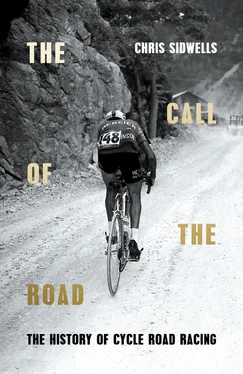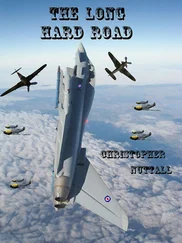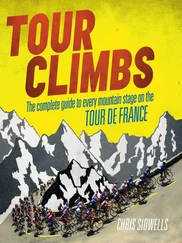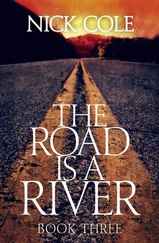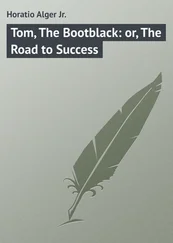The first ever Milan–San Remo more or less followed the route of a race between the two places in 1906. That was a two-day stage race for amateurs only, but buoyed by the success of Milan–Milan, which attracted enormous crowds, Tullo Morgagni negotiated with the San Remo Cycling Club, and La Gazzetta dello Sport took over running the race in 1907, making it a single-day race for professionals.
Thirty-three riders, all men, set off from Milan at 5.18 a.m. on 14 April 1907. The distance was 288 kilometres, not long compared with other races of the same period, but Milan–San Remo is now the longest single-day race in the men’s World Tour. It rained throughout. The best riders took over 11 hours to reach San Remo on a course that crossed the plains south of Milan, climbed the Turchino Pass then descended towards the Mediterranean. When the riders hit the coast, they turned right and headed west along the water’s edge and over the headlands: the Capo Mele, Capo Cervo and Capo Berta.
The field included Carlo Galetti, Luigi Ganna, Giovanni Gerbi, Gustave Garrigou. The race finished on the Corso Cavallotti in San Remo, where Lucien Petit-Breton won by 35 seconds from Garrigou and Gerbi. Only fourteen riders got through to the end, with last man Luigi Rota finishing over three and a half hours behind Petit-Breton.
Through Morgagni and the success of his races, La Gazzetta dello Sport planted its flag firmly on early twentieth-century Italian cycling, but then in 1908 word got round that Corriere della Sera were planning a Tour of Italy, a big stage race like the Tour de France. That could have blown La Gazzetta ’s lead in Italian cycling, so Morgagni convinced the paper’s owner, Emilio Costamagna, and its editor, Armando Cougnet, to use the experience and goodwill gained from Milan–San Remo and Giro di Lombardia to organise a Tour of Italy as soon as possible.
On 7 August 1908, La Gazzetta announced that the first Tour of Italy, known nowadays almost universally by its Italian title, Giro d’Italia, would run in 1909. It would start in Milan on 13 May with a 397-kilometre stage to Bologna, and end on 30 May with a 206-kilometre stage from Turin to Milan. There were six stages in between: the shortest being 228 kilometres and the longest 378 kilometres.
The first Giro avoided the high mountains, but still included some stiff climbs, like the ascents to Roccaraso, Rionero-Sannitico and Macerone on stage three between Naples and Chieti. The steep Passo Bracco featured on stage six from Florence to Genoa, and the Colle di Nava was a stiff test on stage seven from Genoa to Turin. As well as top Italian racers, other competitors included the French rider Lucien Petit-Breton and the Belgian Cyriel Van Hauwaert, so the first Giro d’Italia was an international race.
Rome was the southern extent, and the riders covered a total distance of 2,448 kilometres over a period of eighteen days; 127 riders started, but only forty-nine made it to the final finish line. The winner was decided on points awarded according to the finish order of each stage. But the problem with awarding the overall victory on points is that the winner might not have completed the course in the fastest time.
That was certainly the case in 1909. Luigi Ganna won the Giro, but he wasn’t the quickest over its entire route. That was the third-placed rider, Giovanni Rossignoli. If the first Giro had been decided on time, Rossignoli would have won by quite a large margin, and deciding the race on points didn’t prevent cheating. Three riders were disqualified before the start of stage three because there was no record of them passing through all the control points on the previous stage. It was later discovered that they had covered quite a large section of the stage by train.
But, like the early Tours de France, the public weren’t put off by such infractions. They probably added spice and intrigue to the race anyway. And going forwards, spice and intrigue created by all sorts of unfair play, scandals and downright cheating became a big part of road racing. And it still doesn’t put too many off the sport.
The first Giro certainly created lots of interest in Italy. An estimated thirty thousand people watched the finish in Milan, and Ganna was a worthy winner. He’d already won Milan–San Remo that year, and he was fifth in the 1908 Tour de France. His prize money helped him set up a bicycle factory in 1912. He also came up with one of the greatest winner’s quotes of all time. At the finish, when asked how he felt now the race was over, Ganna replied, ‘My backside is on fire.’
Second overall, Carlo Galetti raced on a Rudge-Whitworth bike made in the British Midlands. He won the next two editions of the Giro d’Italia, but after his initial second place Galetti switched to Atala, then the Bianchi team, so raced on their brands when he won. The 1912 Giro d’Italia team race was won by Atala. The last Giro decided on points was won by Carlo Oriana in 1913. Then Alfonso Clazolari won on time in 1914, before the race was halted by the First World War.
It resumed again in 1919 when Costante Giradengo won, and from then until after the Second World War the Giro was dominated by Italians. Other nationalities competed, but they found it hard to race against the Italians, who would unite to see an Italian winner, no matter what part of the country he came from, or what team he rode for.
The Giro was suspended again during most of the Second World War, with no race from 1941 to 1945. Straight after the war Italians continued winning through Gino Bartali, Fausto Coppi and Fiorenzo Magni. Coppi’s 1947 win was particularly remarkable since he’d had to build himself back up after being a prisoner of war. It also came at the expense of his arch rival, Gino Bartali.
Coppi and Bartali – they are never introduced the other way around despite Bartali being older and ahead of Coppi in the alphabet – were almost at war themselves at the time. The pious Bartali represented the ideals of old Italy, whereas Coppi was seen as a more modern man. Bartali was the hero of the rural and older Italians. Coppi’s fans were younger city dwellers and business people. Before the start of the 1947 Giro, Bartali declared with typical Italian passion that to win the race, ‘Coppi will have to cross my dead body.’ Italy was a froth of widely differing views and passions by the time Coppi won.
The Italian stranglehold was finally broken in 1950 by a Swiss rider, Hugo Koblet. Nicknamed Le Pédaleur de Charme because of his impeccable riding style and appearance, Koblet kept a comb and a sponge soaked in eau de cologne in his racing jersey, so that he could freshen up towards the end of a race and wouldn’t appear in next day’s newspapers covered in mud and sweat.
But Koblet was more than a cycling dandy, he had immense class, as he proved by winning the 1950 Giro, then the Tour de France in 1951, almost entirely without team support in either race. Koblet later suffered from an illness involving his kidneys, from which he never really recovered. He stopped racing in 1958, and six years later he died in a car crash, which some say was suicide. Koblet was travelling at great speed between Zurich and Esslingen when his Alfa Romeo piled into a tree. The road was straight, weather conditions were good and it was daylight, but witnesses said that the driver made no effort to deviate from his course, or to slow down. He just piled straight into the tree.
With Koblet’s victory the Giro’s profile began to grow internationally. Another Swiss rider, Carlo Clerici, won in 1954, then the Luxembourger Charly Gaul won in 1956. And he did it with his trademark devastation of a Grand Tour in one stage in terrible weather. Gaul was a beautiful climber, called the Angel of the Mountains by the press, but he was also incredibly tough, which made him doubly dangerous when bad weather hit the mountains. Cold didn’t seem to affect him, or maybe he could just suffer and push himself more than others.
Читать дальше
